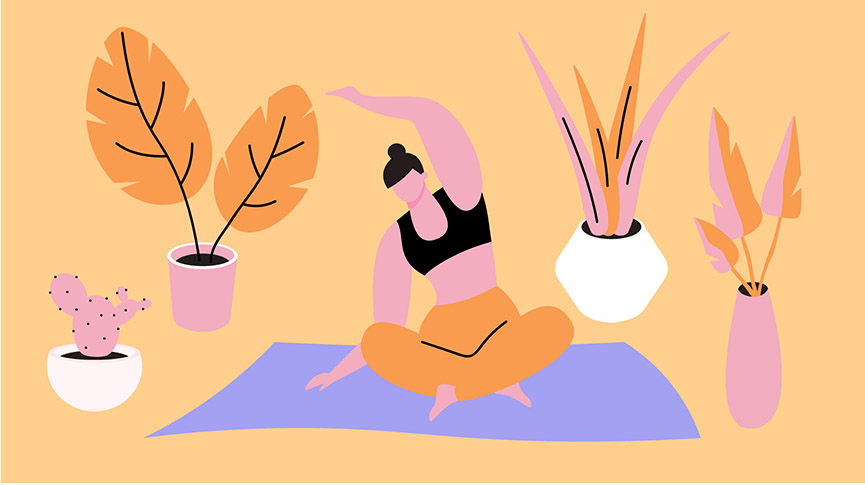Postpartum Exercise: Where to Start

You’ve just been through one of the biggest physical challenges of your life: giving birth to another human. You’ll definitely need time to rest and bond with your baby, but it’s also important to start thinking about getting back into shape. Exercise is beneficial to your health at all stages of life but it’s particularly important after childbirth – a good routine will help you recover faster and boost your mood and energy levels. It can be hard to know where to start, but here are a few simple ways to ease yourself back in.
Things to Remember
- Talk to your doctor before starting: some factors, like a c-section or complications during birth, may require you to take it easy for a little longer.
- Pay attention to your joints: your muscles and ligaments have stretched and loosened to accommodate your baby so you might be more prone to injury.
- Keep an eye on postpartum bleeding: if it becomes heavier or redder stop and see your doctor.
- Start slowly and listen to your body: there’s no need to tire yourself out – with a new born at home that’s the last thing you need!
Exercises to Ease You In:
It might feel like you could jump right back into your old routines but your body will still feel the effects of pregnancy for a while after birth. Here are a couple of simple (but effective!) ways you can get moving in the very early days after giving birth:
Kegels
Kegel exercising is a must for new moms and can be started within a few days after you give birth. These small, conscious contractions of the pelvic floor increase blood flow to the perineum and vagina, which helps to reduce swelling or bruising and heal any tears or episiotomy incisions from childbirth. More importantly, Kegels strengthen the pelvic floor, which is responsible for supporting your pelvic organs and controlling your bladder.
During pregnancy your pelvic floor has stretched to accommodate your little one, and during childbirth you use those muscles to push her out into the world. So it’s no wonder that most new moms have issues with bladder leaks – regardless of whether they had a vaginal birth or a c-section. Kegel exercise helps prevent and treat bladder leaks, so start doing them on your own as soon as you can (even if it feels like nothing’s happening). Once your doctor says you’re healed (around 6 weeks) you can start using a smart exerciser to guide you through a personalized routine, so you get better, more rapid results. A smart exerciser analyzes your pelvic strength and endurance, and determines the best routine for your level. That way you don’t have to figure out how many contractions to do, how long to hold, or how long your routine should last – the exerciser does it all for you!
Walking
While it can be challenging to leave the house with a new born, a walk is a fantastic way to avoid cabin fever and get some fresh air. It’s also a low-impact way to burn calories and get those endorphins flowing (yay for mood boosting hormones!). You can even take baby with you in the stroller and show her off around the neighborhood. Adjust the stroller handle to a comfortable height so you’re not stooping and set out for a 30 minute stroll. Start slow at first and pay attention to your pelvic floor, if it feels heavy or uncomfortable keep the walks short until it’s stronger.
Pelvic Tilt
Your tummy muscles are going to need quite a bit of attention after pregnancy but make sure to talk to your doctor about any risks or issues that might require a specific routine (like diastasis recti, a separation of the abdominal muscles common in new moms). Start off with something very gentle like a pelvic tilt to work your lower abs, lower back and pelvic floor. Lie on your back with your knees bent and feet on the floor – your lower back will naturally be slightly elevated off of the ground. Contract your pelvic floor and pull in your lower abs while bending or tilting your pelvis up slightly. This will bring your lower back flat against the floor, but your butt will not lift off of the ground. Hold for a count of 10 (or as long as you can) and then relax your muscles and return to the starting position. Start with 5 repetitions and work up to 20. Remember to breathe throughout the exercise. The image below shows the correct motion:
You’re just getting started again, so try to just enjoy yourself. Exercise is a great way to relax, de-stress and focus on your own wellbeing for a little while, which can be a welcome break at the beginning. You’ll be amazed at how good you (and your baby) start to feel once you get moving! Keep the exercise low-impact and avoid anything that puts strain on your pelvic floor until you’ve healed a little more. As you feel stronger you can increase the intensity of your exercises, but always listen to your body and talk to your doctor if you have any concerns.

A collective group of “lady experts” at Intimina who love sharing our personal experiences, even when they are a little too personal. We believe it’s time to start breaking down the taboos around menstruation, motherhood, and menopause, and start owning our female health.



